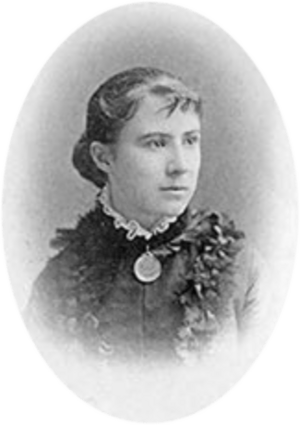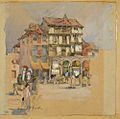Harriet Mary Ford facts for kids
Quick facts for kids
Harriet Mary Ford
|
|
|---|---|

Harriet Mary Ford, 1878
|
|
| Born | 1859 Brockville, Ontario, Canada
|
| Died | October 31, 1938 Bovingdon Green, Buckinghamshire, England
|
| Occupation | Artist, Critic, Lecturer, Writer |
| Known for | Painter, Muralist, Jeweler |
Harriet Mary Ford (born 1859, died 1938) was a talented Canadian artist. She was known for her work as a painter, a muralist (someone who paints large artworks on walls), and a jeweller. Harriet Ford was also a critic, writer, and lecturer. She was very knowledgeable about Renaissance art and artists. Ford was part of many art groups and even started the Society of Mural Decorators in 1894. She was seen as an example of the "Canadian New Woman," meaning she was independent and focused on her career.
Contents
Early Life and Education
Harriet Ford was born in Brockville, Ontario, Canada, in 1859. Her father, David B. Ogden Ford, was a lawyer. When she was ten years old, she became an orphan. Ford then attended a private Anglican girls' school called the Bishop Strachan School from 1870 to 1878.
Art Training and Travels
Ford studied art at several famous schools. In Canada, she went to the Central Ontario School of Art in Toronto. She also studied in England at the St John's Wood Art School and the Royal Academy in London. In France, she learned at the Académie Colarossi in Paris and with artists like Luc-Olivier Merson. She also spent time training in Italy. After all this training, she focused on painting murals, creating other artworks, and making jewellery.
Harriet Ford loved to travel and spent much of her life exploring. She visited countries like Italy, Spain, and England. She lived in Canada and England at different times. In England, she shared a cottage with other artists, Edith Hayes and Sydney Strickland Tully. While she visited many places, Ford especially liked spending time in St. Ives. Her travels helped her develop new and exciting ideas about art. Some people even called her ideas "dangerous" because they were so new!
Ford worked full-time as a writer, lecturer, and artist. She was unmarried and financially independent. This made her a great example of the "Canadian New Woman." This position had both good and challenging parts. For example, in 1896, Ford won a competition for a poster design for the Toronto Horse Show. An anonymous critic in Saturday Night magazine criticized her poster and the idea of the "New Woman."
Harriet Ford believed that Canadian artists should be free to find inspiration anywhere in the world. She felt that painting Canadian scenes was not the only way to be a Canadian artist.
Harriet Ford's Art Career
Harriet Ford created many different types of art. Her works are now in important public collections. These include the National Gallery of Canada, the Art Gallery of Ontario, and the Art Gallery of Hamilton.
As a Painter
Ford mainly used oil paint, watercolour, and pastel in her paintings. She showed her art in many places, including the Royal Canadian Academy and the Paris Salon. At the Royal Canadian Academy Exhibition in 1895, she displayed four of her own pieces. These included Girl in White, Annunciation, a decorative oil panel, and a self-portrait.
In 1896, Ford won a competition for a horse show poster design. She beat several well-known artists from Montreal. The poster used red, yellow, blue, and black colours. It was later shown in an art exhibition in Montreal. Some people criticized it for being different from traditional art. However, many critics also noted that Ford had intentionally broken these rules about colour and perspective. They knew it wasn't because she lacked skill. The poster was even mailed to other artists for their personal collections.
While living abroad, Ford also made sketches of the places she visited. She sent these sketches back to Canada. One of them was even published in Canadian Magazine in 1896.
As a Muralist
Ford also decorated homes with her art. This included furniture, screens, and murals. Murals are large paintings done directly on walls. Unfortunately, not many of these works still exist today. Ford was interested in murals as early as 1895, when she gave a lecture about them in Toronto. She was one of the few female Canadian artists at that time to get paid to create murals.
She painted murals in the homes of wealthy people like Charles Porteous. She also created murals for public places. For example, she made her "Mother and Child" mural for Saint John's Convalescent Hospital in Toronto. She was part of the Canadian Mural Decorator's Society. In 1898, she worked on a project to decorate Union Station in Toronto with a mural about Canadian railway builders. However, this project was not completed.
As a Jeweller
Between 1908 and 1912, Ford started designing and making jewellery. She likely learned jewellery making from the Arts and Crafts movement while she was in England. She began working with silver and later started using gold in her pieces. Like many jewellers from the Arts and Crafts Movement, Ford used semi-precious stones. These included stones like turquoise, mother of pearl, and different types of pearls.
Her jewellery was shown in an exhibition at the Art Gallery of Hamilton in 2001. Some of her pieces were also part of the "Artists, Architects & Artisans: Canadian Art 1890-1918" exhibition. This show took place at the National Gallery of Canada in Ottawa, Ontario, in 2013.
Social and Academic Life
In the late 1890s, Harriet Ford gave several lectures based on her studies in Italy. Many people attended these lectures. Sometimes, they even had to move to a bigger room to fit everyone! Ford's lectures were about early Renaissance art and artists. She was considered an expert on this topic.
Ford gave her first lecture about Giotto and his followers to the Ontario Society of Artists on March 19, 1895. People described her as a "competent lecturer" who kept the audience interested. Ford mentioned other experts in her lectures, like art historian John Ruskin. But she also shared her own research and ideas.
Ford's thoughts on Canadian art were also shared in publications. For example, in J. Russell Harper's book Painting in Canada: A History, Ford is quoted. She said that she did not believe painting Canadian scenes was necessary for an artist to be part of the Canadian art world.
In 1896, Ford helped start Tarot magazine with George Agnew Reid and Carl Ahrens. She was an editor for this magazine, which focused on the Arts and Crafts movement.
Groups and Affiliations
Harriet Ford was a member of many important art groups and societies. She was an Associate of the Royal Canadian Academy of Arts from 1895 to 1899. She also belonged to the Palette Club, the Ontario Society of Artists, and the Women's International Art Club. In 1894, she helped found the Society of Mural Decorators.
Death and Legacy
Harriet Ford passed away in Great Marlow, Buckinghamshire, England, on October 10, 1938. Many of her artworks are kept in major Canadian art galleries. These include the National Gallery of Canada, the Art Gallery of Ontario, and the Art Gallery of Hamilton. Her work continues to be studied and appreciated today.
Images for kids






